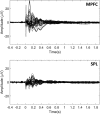Resting state brain dynamics and its transients: a combined TMS-EEG study
- PMID: 27488504
- PMCID: PMC4973226
- DOI: 10.1038/srep31220
Resting state brain dynamics and its transients: a combined TMS-EEG study
Abstract
The brain at rest exhibits a spatio-temporally rich dynamics which adheres to systematic behaviours that persist in task paradigms but appear altered in disease. Despite this hypothesis, many rest state paradigms do not act directly upon the rest state and therefore cannot confirm hypotheses about its mechanisms. To address this challenge, we combined transcranial magnetic stimulation (TMS) and electroencephalography (EEG) to study brain's relaxation toward rest following a transient perturbation. Specifically, TMS targeted either the medial prefrontal cortex (MPFC), i.e. part of the Default Mode Network (DMN) or the superior parietal lobule (SPL), involved in the Dorsal Attention Network. TMS was triggered by a given brain state, namely an increase in occipital alpha rhythm power. Following the initial TMS-Evoked Potential, TMS at MPFC enhances the induced occipital alpha rhythm, called Event Related Synchronisation, with a longer transient lifetime than TMS at SPL, and a higher amplitude. Our findings show a strong coupling between MPFC and the occipital alpha power. Although the rest state is organized around a core of resting state networks, the DMN functionally takes a special role among these resting state networks.
Figures



αSPL and αMPFC are not significantly different from αRest-state t = 0.28–0.45 s.
αMPFC significantly higher than αSPL (p = 0.03) t = 0.78–1.44 s.
αMPFC significantly higher than αRest-state (p = 0.0016) t = 0.48–2.07 s.
αSPL significantly higher than αRest-state (p = 0.0207) t = 0.47–1.7 s.

References
Publication types
MeSH terms
LinkOut - more resources
Full Text Sources
Other Literature Sources

